Business Process Modelling for Desklib
VerifiedAdded on 2023/06/04
|20
|2867
|276
AI Summary
This article discusses Business Process Modelling and its strategies, objectives, and achievements. It explains how BPM can be applied to improve business performance and efficiency. It also includes a case study of Birkbeck University and how they adopted BPM to improve data quality and increase speed. Additionally, it covers the link between Enterprise Architecture and BPM, the size of BPM, and how CBPE was carried out with respect to the MAS VENUE SERVICES case study.
Contribute Materials
Your contribution can guide someone’s learning journey. Share your
documents today.
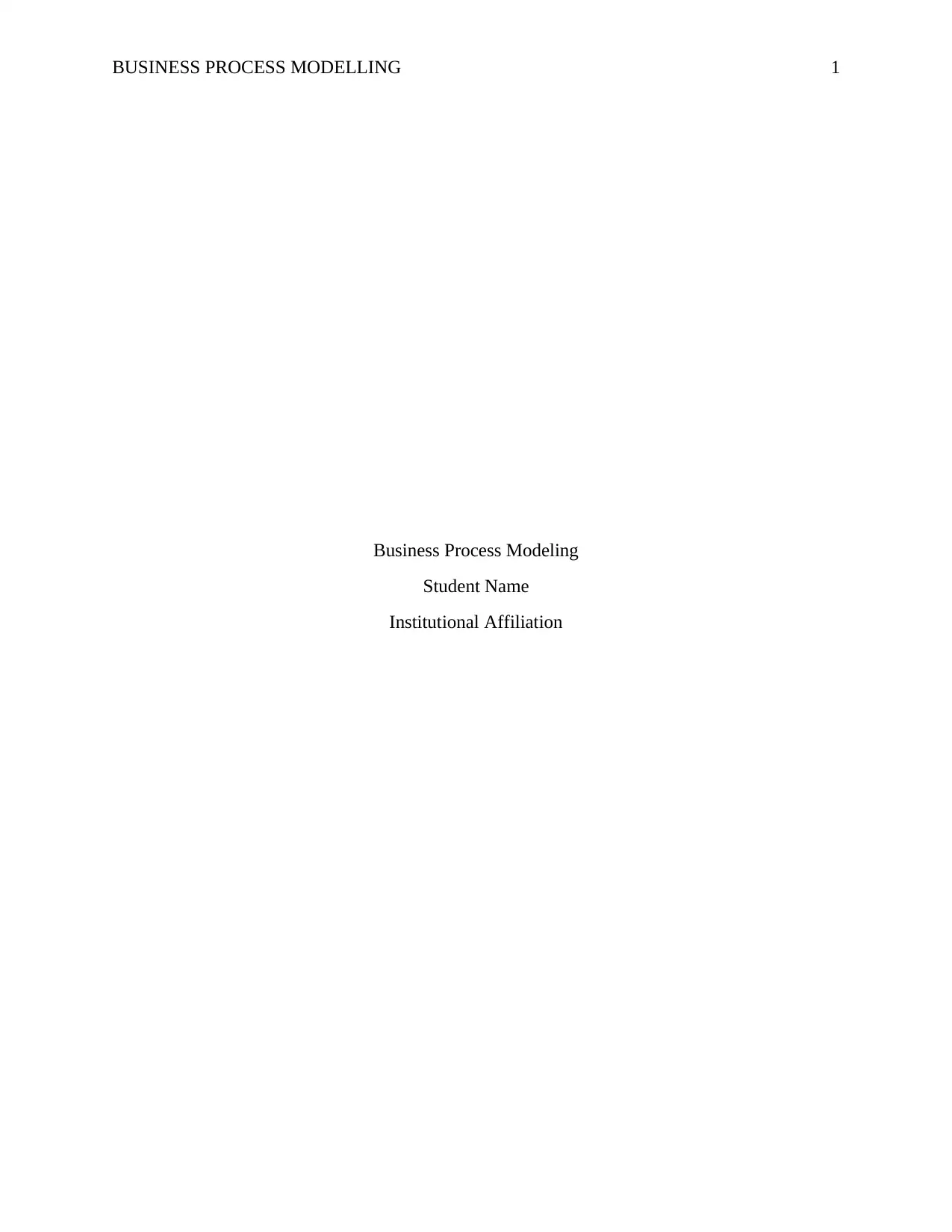
BUSINESS PROCESS MODELLING 1
Business Process Modeling
Student Name
Institutional Affiliation
Business Process Modeling
Student Name
Institutional Affiliation
Secure Best Marks with AI Grader
Need help grading? Try our AI Grader for instant feedback on your assignments.
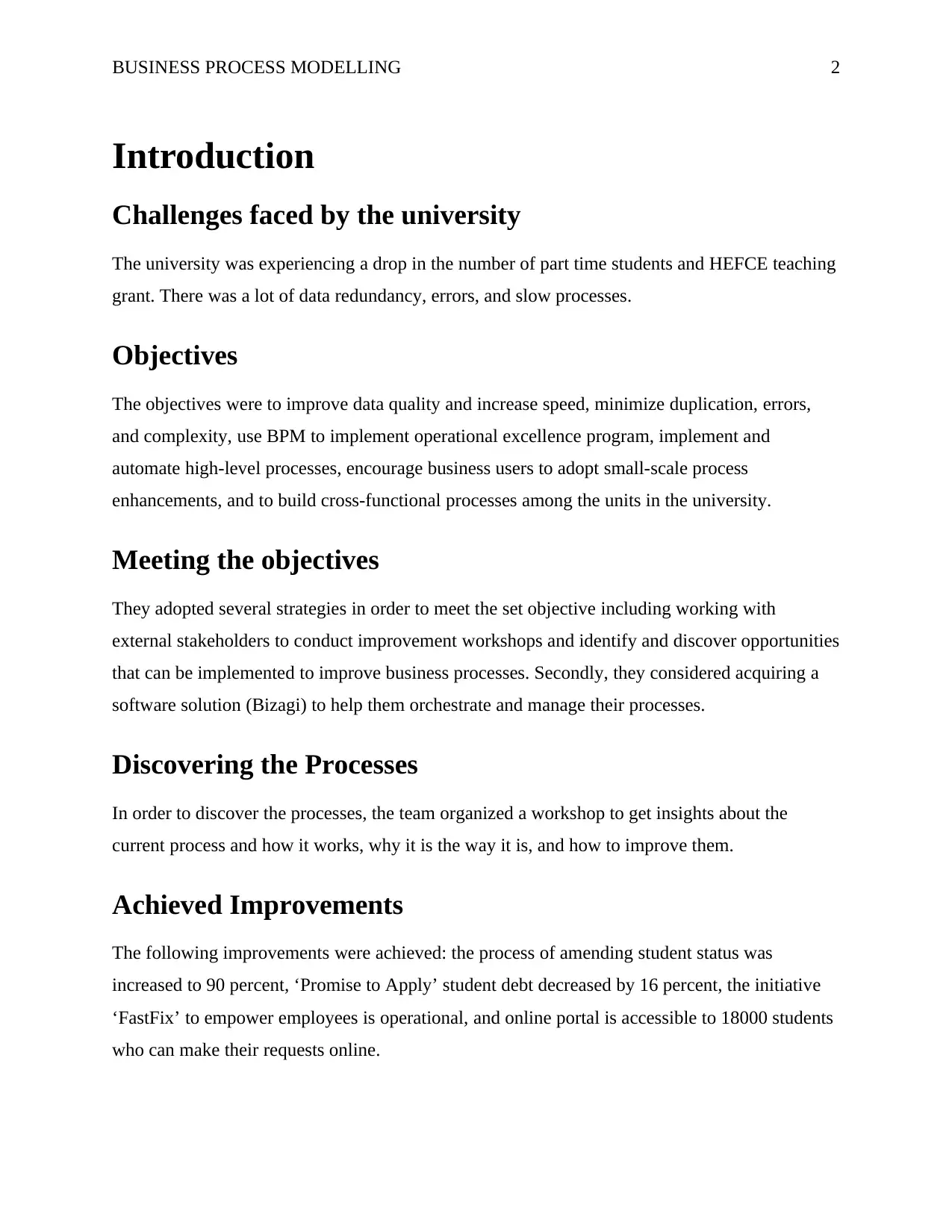
BUSINESS PROCESS MODELLING 2
Introduction
Challenges faced by the university
The university was experiencing a drop in the number of part time students and HEFCE teaching
grant. There was a lot of data redundancy, errors, and slow processes.
Objectives
The objectives were to improve data quality and increase speed, minimize duplication, errors,
and complexity, use BPM to implement operational excellence program, implement and
automate high-level processes, encourage business users to adopt small-scale process
enhancements, and to build cross-functional processes among the units in the university.
Meeting the objectives
They adopted several strategies in order to meet the set objective including working with
external stakeholders to conduct improvement workshops and identify and discover opportunities
that can be implemented to improve business processes. Secondly, they considered acquiring a
software solution (Bizagi) to help them orchestrate and manage their processes.
Discovering the Processes
In order to discover the processes, the team organized a workshop to get insights about the
current process and how it works, why it is the way it is, and how to improve them.
Achieved Improvements
The following improvements were achieved: the process of amending student status was
increased to 90 percent, ‘Promise to Apply’ student debt decreased by 16 percent, the initiative
‘FastFix’ to empower employees is operational, and online portal is accessible to 18000 students
who can make their requests online.
Introduction
Challenges faced by the university
The university was experiencing a drop in the number of part time students and HEFCE teaching
grant. There was a lot of data redundancy, errors, and slow processes.
Objectives
The objectives were to improve data quality and increase speed, minimize duplication, errors,
and complexity, use BPM to implement operational excellence program, implement and
automate high-level processes, encourage business users to adopt small-scale process
enhancements, and to build cross-functional processes among the units in the university.
Meeting the objectives
They adopted several strategies in order to meet the set objective including working with
external stakeholders to conduct improvement workshops and identify and discover opportunities
that can be implemented to improve business processes. Secondly, they considered acquiring a
software solution (Bizagi) to help them orchestrate and manage their processes.
Discovering the Processes
In order to discover the processes, the team organized a workshop to get insights about the
current process and how it works, why it is the way it is, and how to improve them.
Achieved Improvements
The following improvements were achieved: the process of amending student status was
increased to 90 percent, ‘Promise to Apply’ student debt decreased by 16 percent, the initiative
‘FastFix’ to empower employees is operational, and online portal is accessible to 18000 students
who can make their requests online.
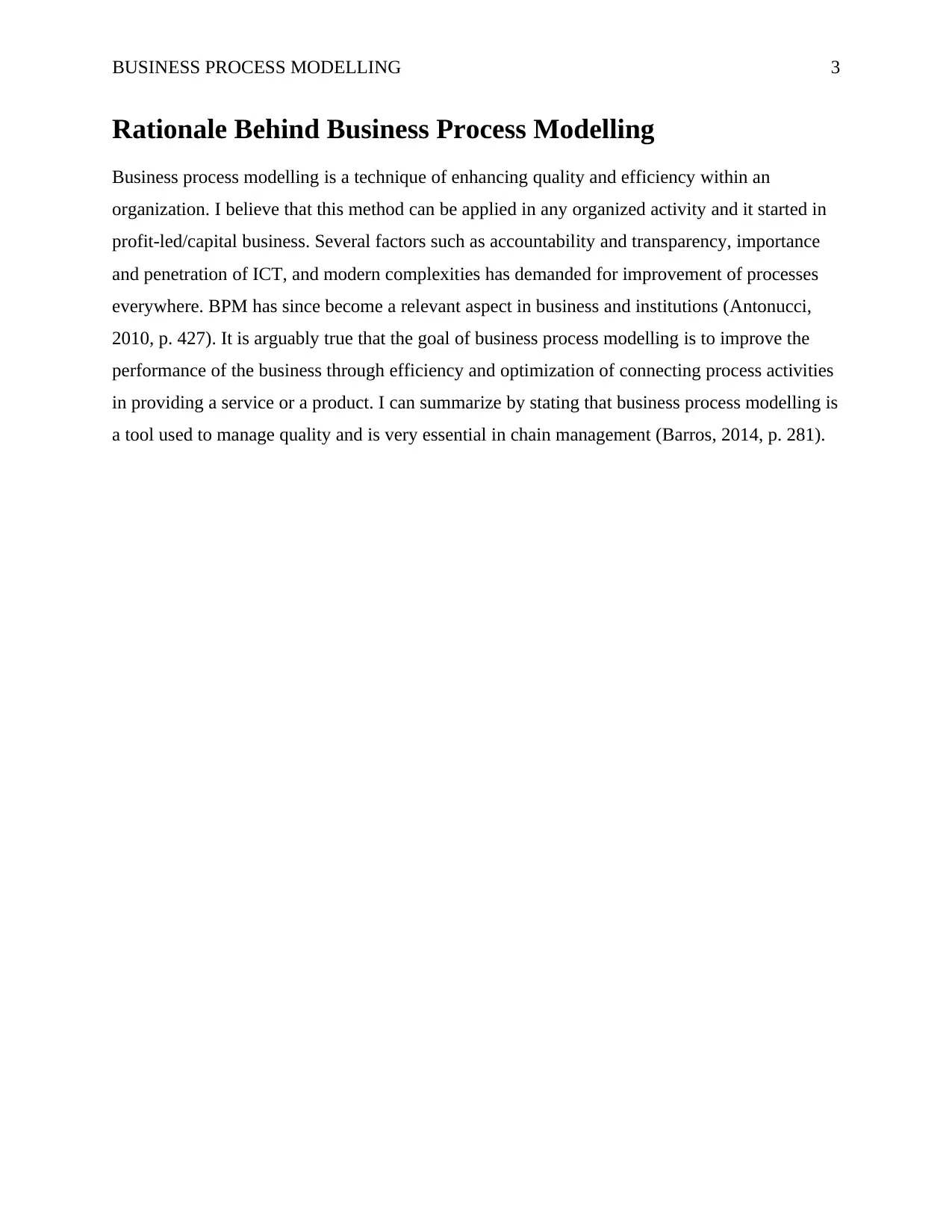
BUSINESS PROCESS MODELLING 3
Rationale Behind Business Process Modelling
Business process modelling is a technique of enhancing quality and efficiency within an
organization. I believe that this method can be applied in any organized activity and it started in
profit-led/capital business. Several factors such as accountability and transparency, importance
and penetration of ICT, and modern complexities has demanded for improvement of processes
everywhere. BPM has since become a relevant aspect in business and institutions (Antonucci,
2010, p. 427). It is arguably true that the goal of business process modelling is to improve the
performance of the business through efficiency and optimization of connecting process activities
in providing a service or a product. I can summarize by stating that business process modelling is
a tool used to manage quality and is very essential in chain management (Barros, 2014, p. 281).
Rationale Behind Business Process Modelling
Business process modelling is a technique of enhancing quality and efficiency within an
organization. I believe that this method can be applied in any organized activity and it started in
profit-led/capital business. Several factors such as accountability and transparency, importance
and penetration of ICT, and modern complexities has demanded for improvement of processes
everywhere. BPM has since become a relevant aspect in business and institutions (Antonucci,
2010, p. 427). It is arguably true that the goal of business process modelling is to improve the
performance of the business through efficiency and optimization of connecting process activities
in providing a service or a product. I can summarize by stating that business process modelling is
a tool used to manage quality and is very essential in chain management (Barros, 2014, p. 281).
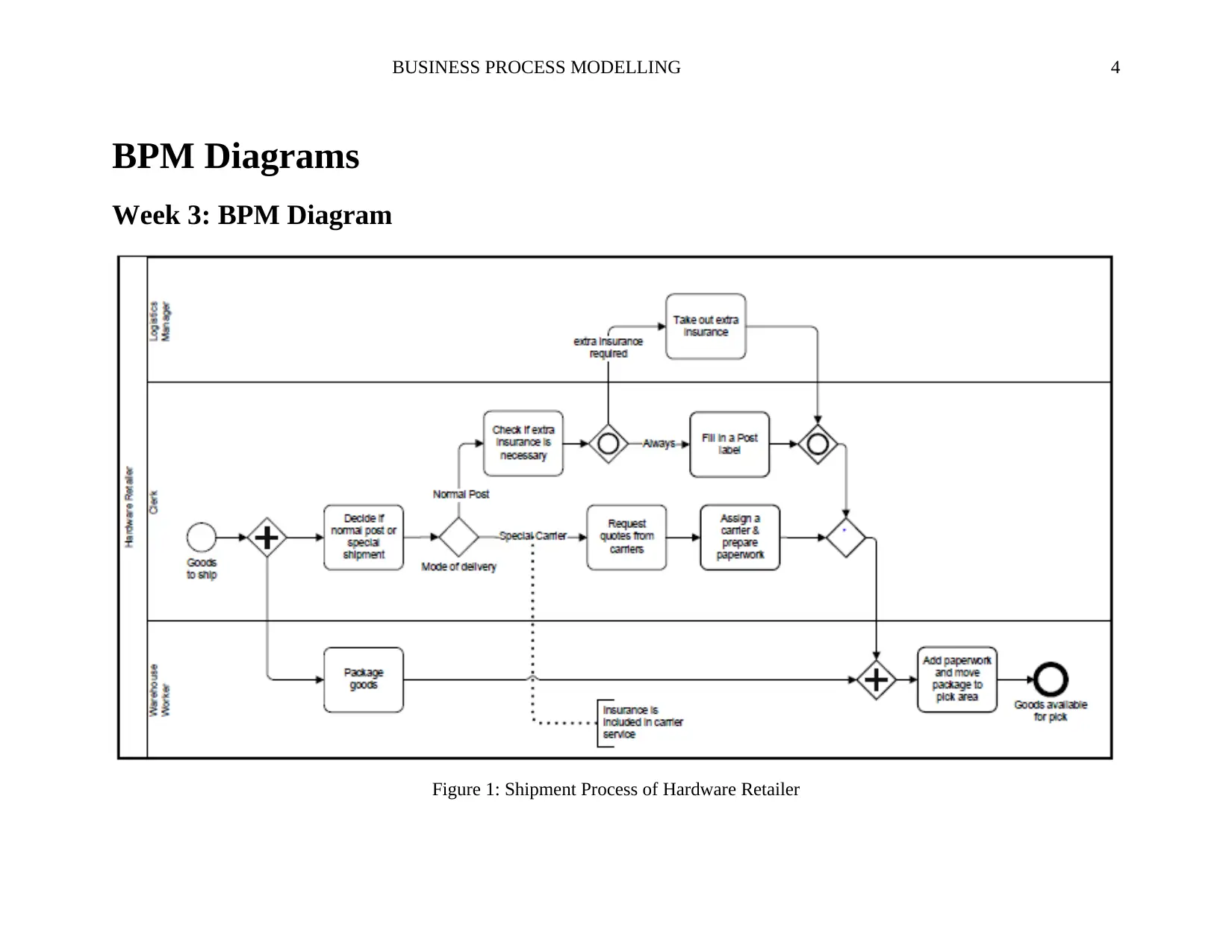
BUSINESS PROCESS MODELLING 4
BPM Diagrams
Week 3: BPM Diagram
Figure 1: Shipment Process of Hardware Retailer
BPM Diagrams
Week 3: BPM Diagram
Figure 1: Shipment Process of Hardware Retailer
Secure Best Marks with AI Grader
Need help grading? Try our AI Grader for instant feedback on your assignments.
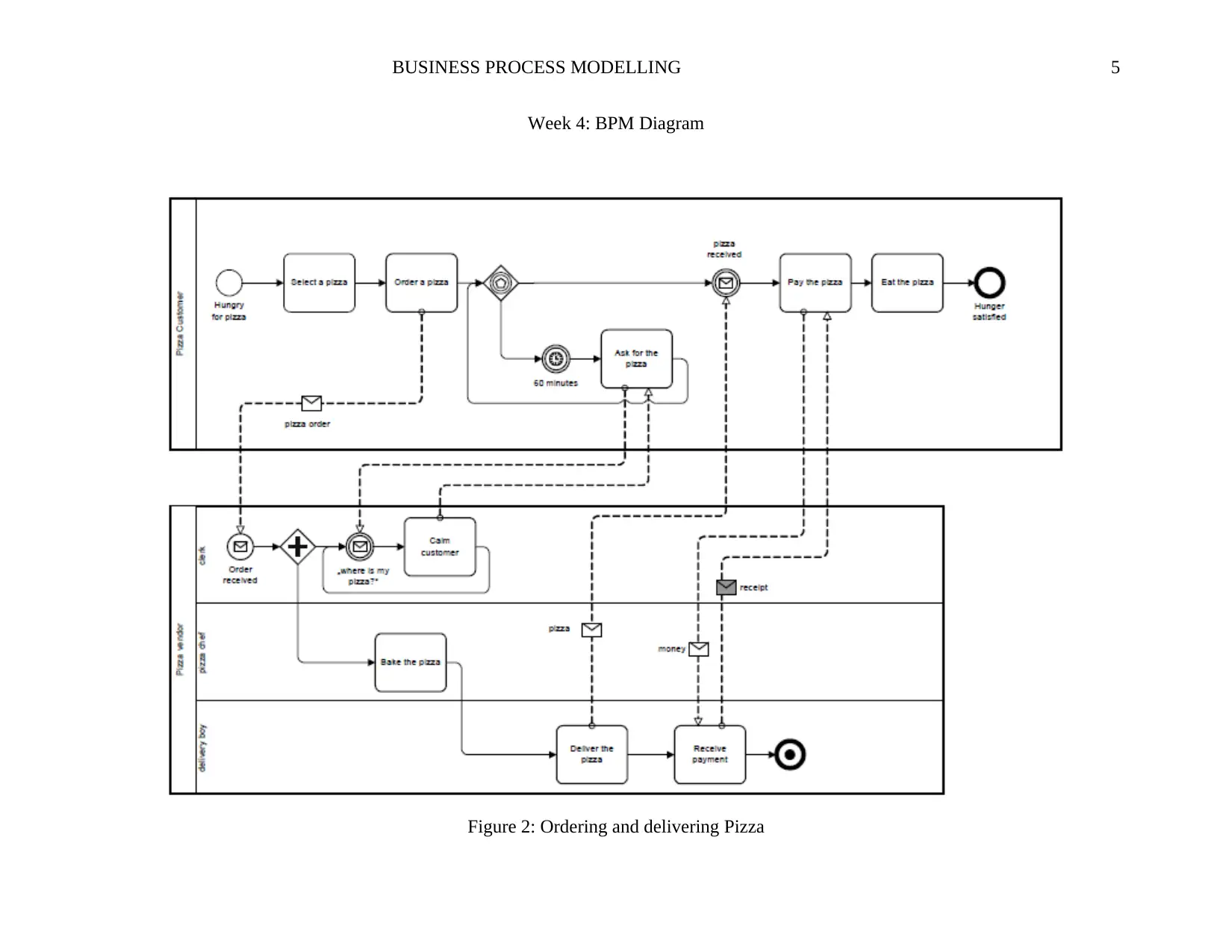
BUSINESS PROCESS MODELLING 5
Week 4: BPM Diagram
Figure 2: Ordering and delivering Pizza
Week 4: BPM Diagram
Figure 2: Ordering and delivering Pizza
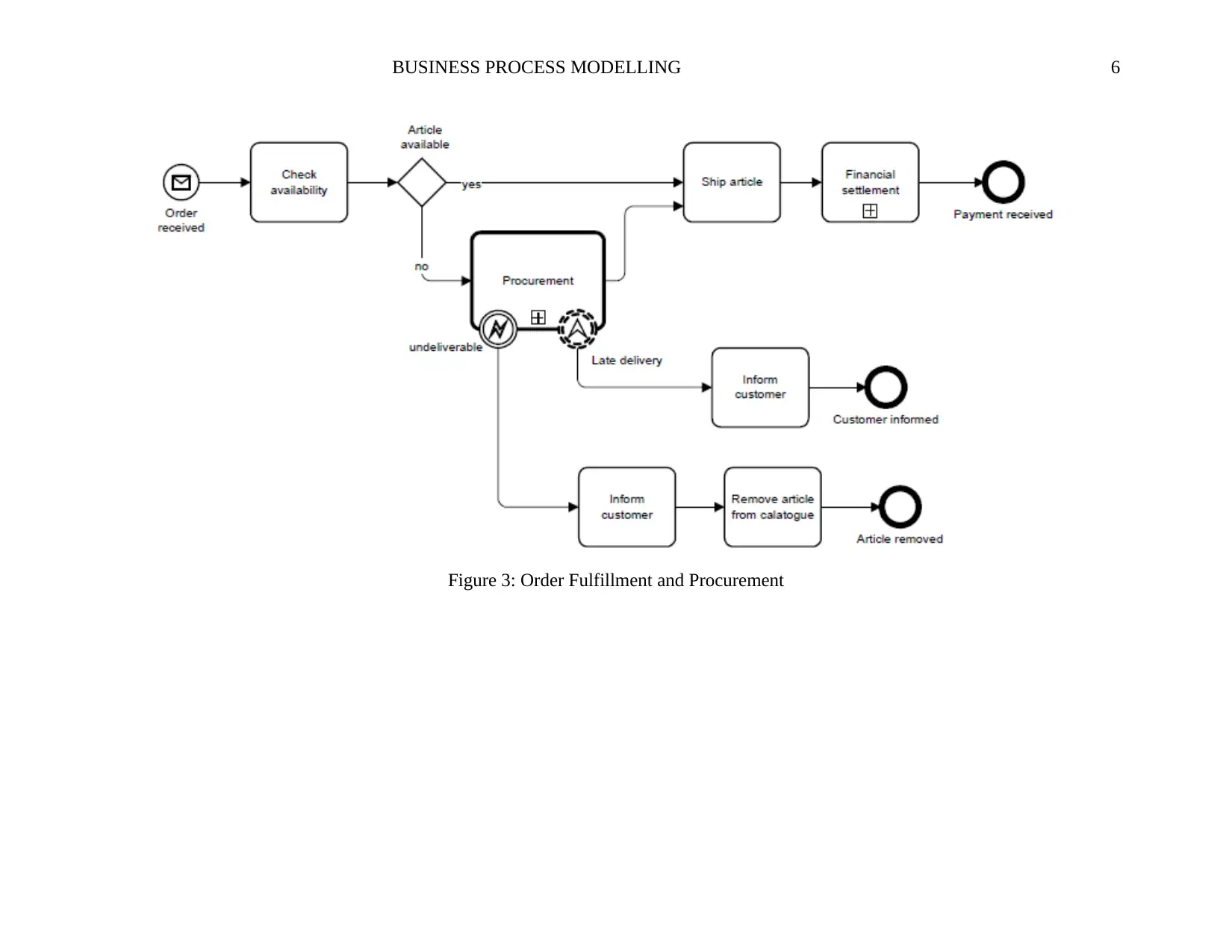
BUSINESS PROCESS MODELLING 6
Figure 3: Order Fulfillment and Procurement
Figure 3: Order Fulfillment and Procurement
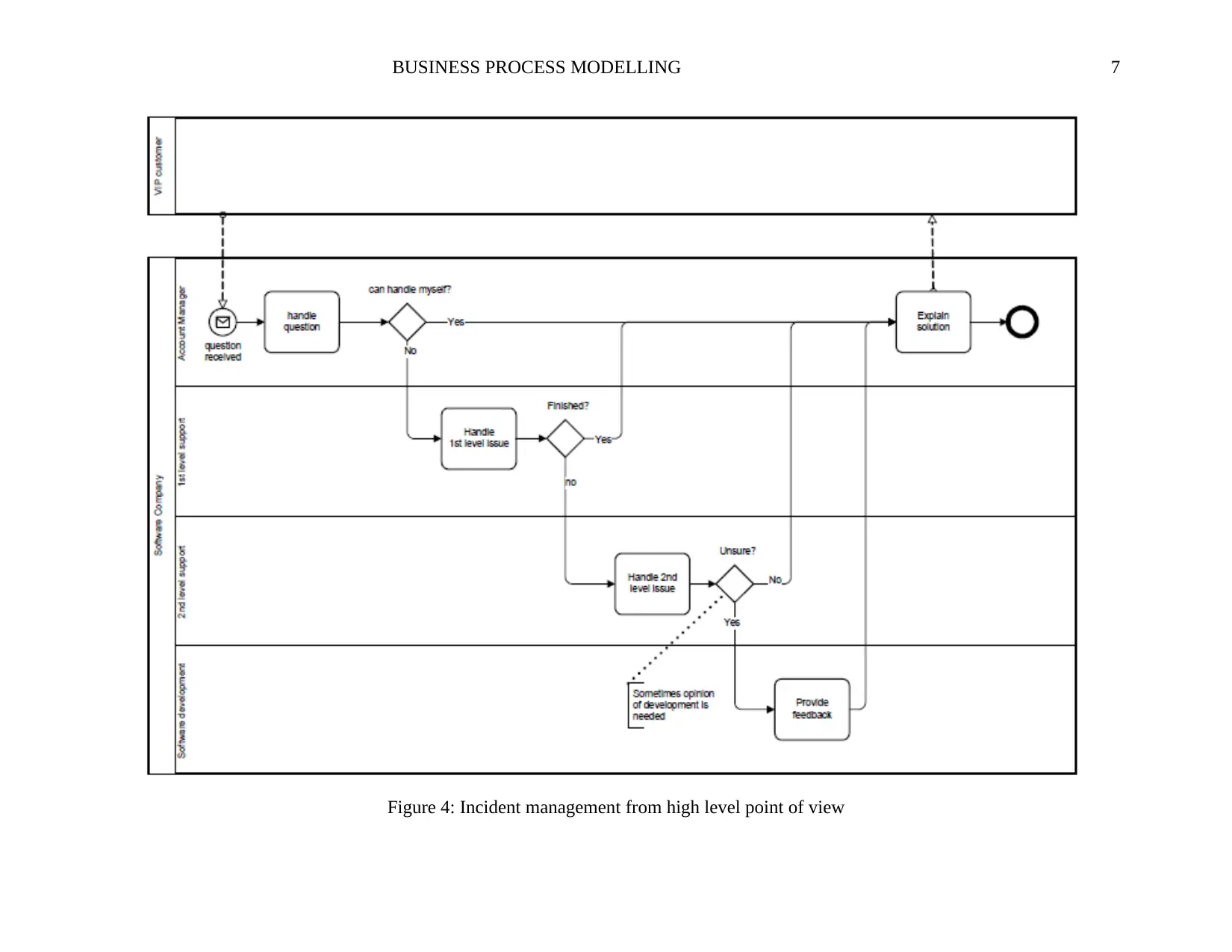
BUSINESS PROCESS MODELLING 7
Figure 4: Incident management from high level point of view
Figure 4: Incident management from high level point of view
Paraphrase This Document
Need a fresh take? Get an instant paraphrase of this document with our AI Paraphraser
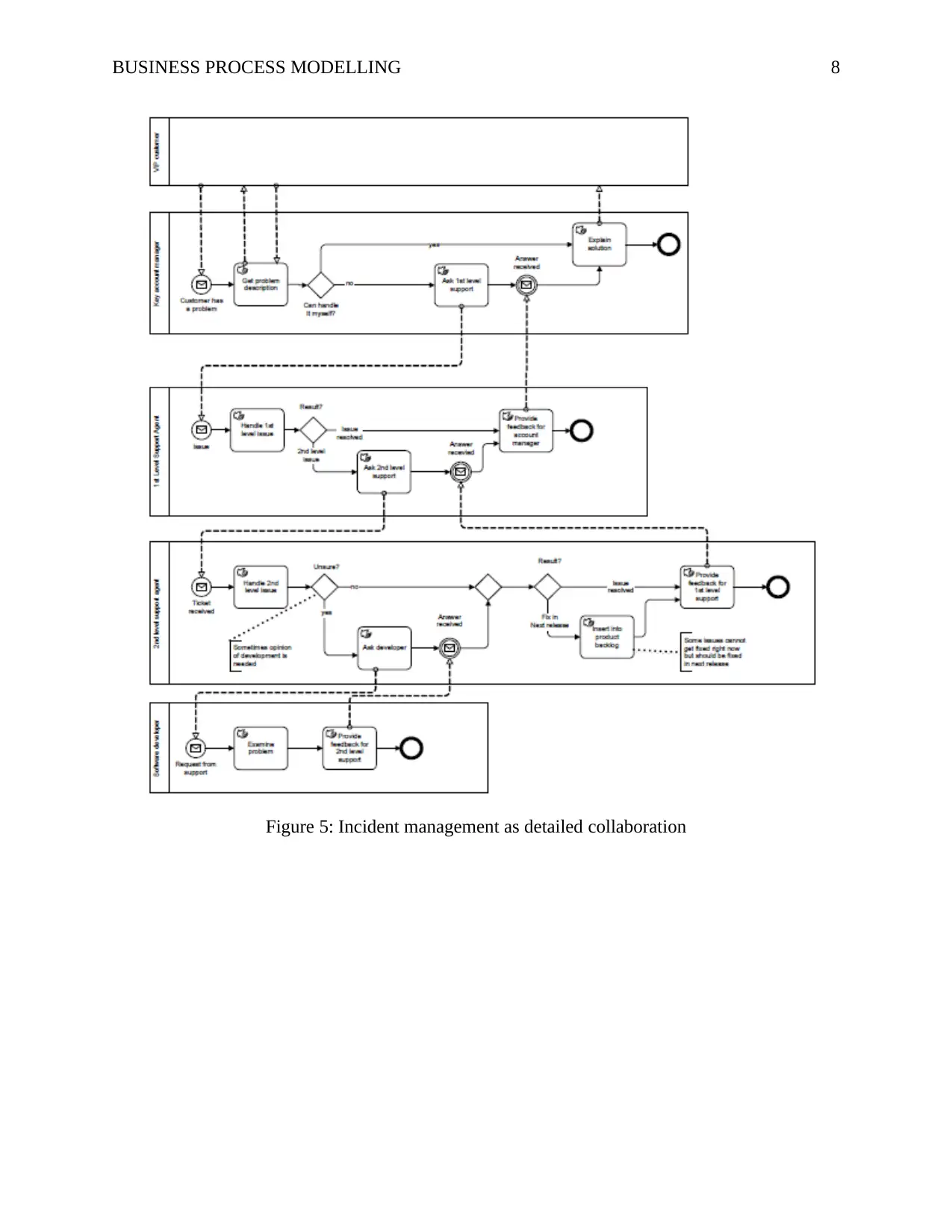
BUSINESS PROCESS MODELLING 8
Figure 5: Incident management as detailed collaboration
Figure 5: Incident management as detailed collaboration
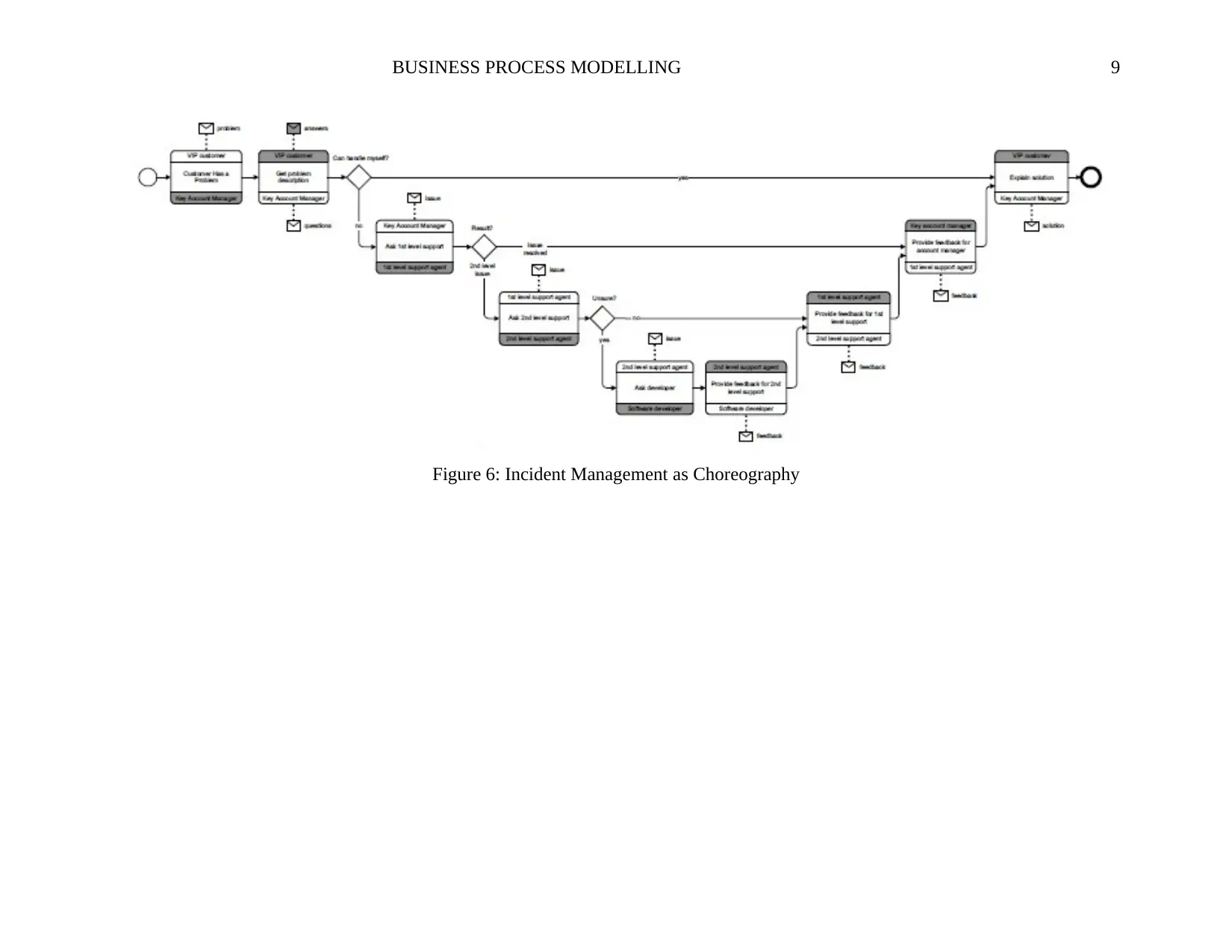
BUSINESS PROCESS MODELLING 9
Figure 6: Incident Management as Choreography
Figure 6: Incident Management as Choreography
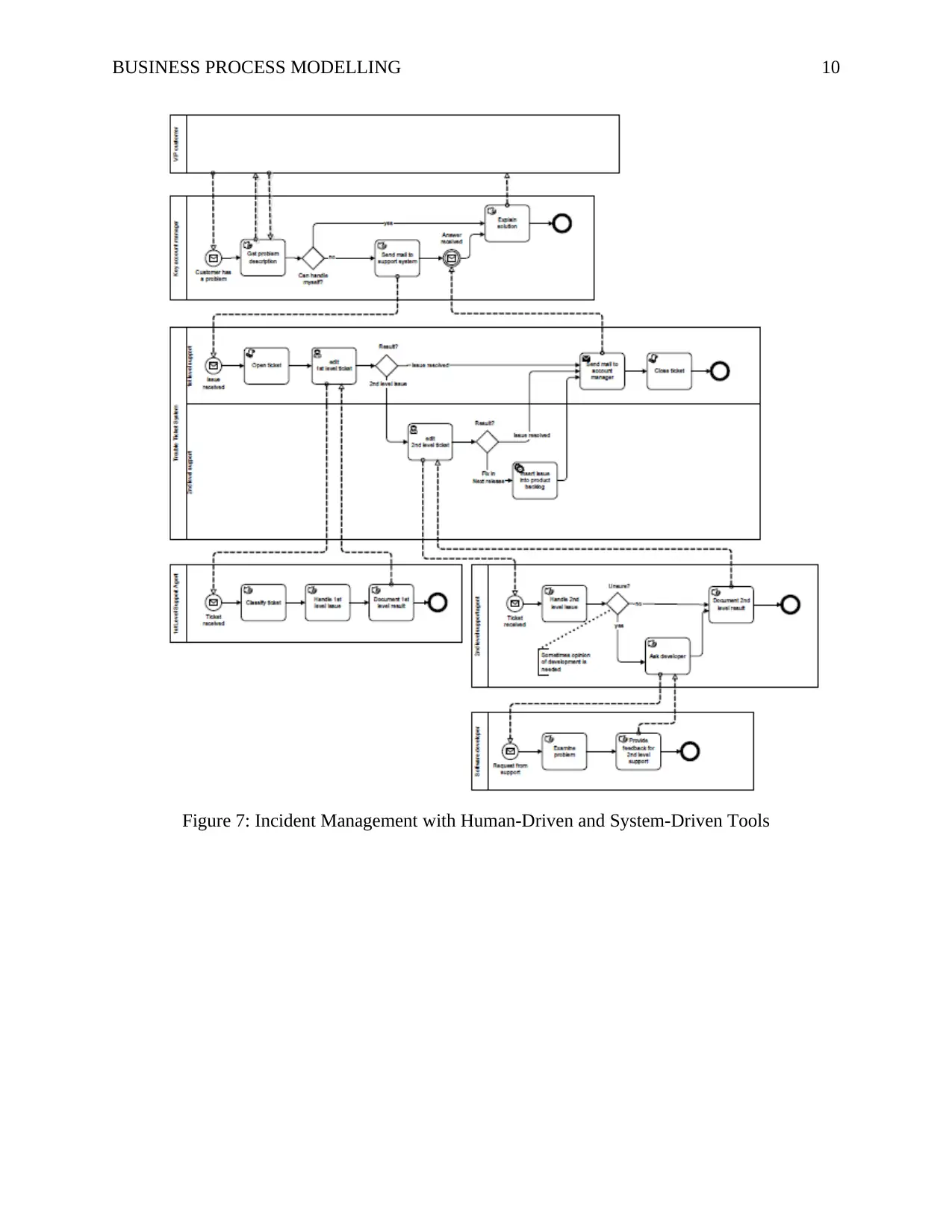
BUSINESS PROCESS MODELLING 10
Figure 7: Incident Management with Human-Driven and System-Driven Tools
Figure 7: Incident Management with Human-Driven and System-Driven Tools
Secure Best Marks with AI Grader
Need help grading? Try our AI Grader for instant feedback on your assignments.
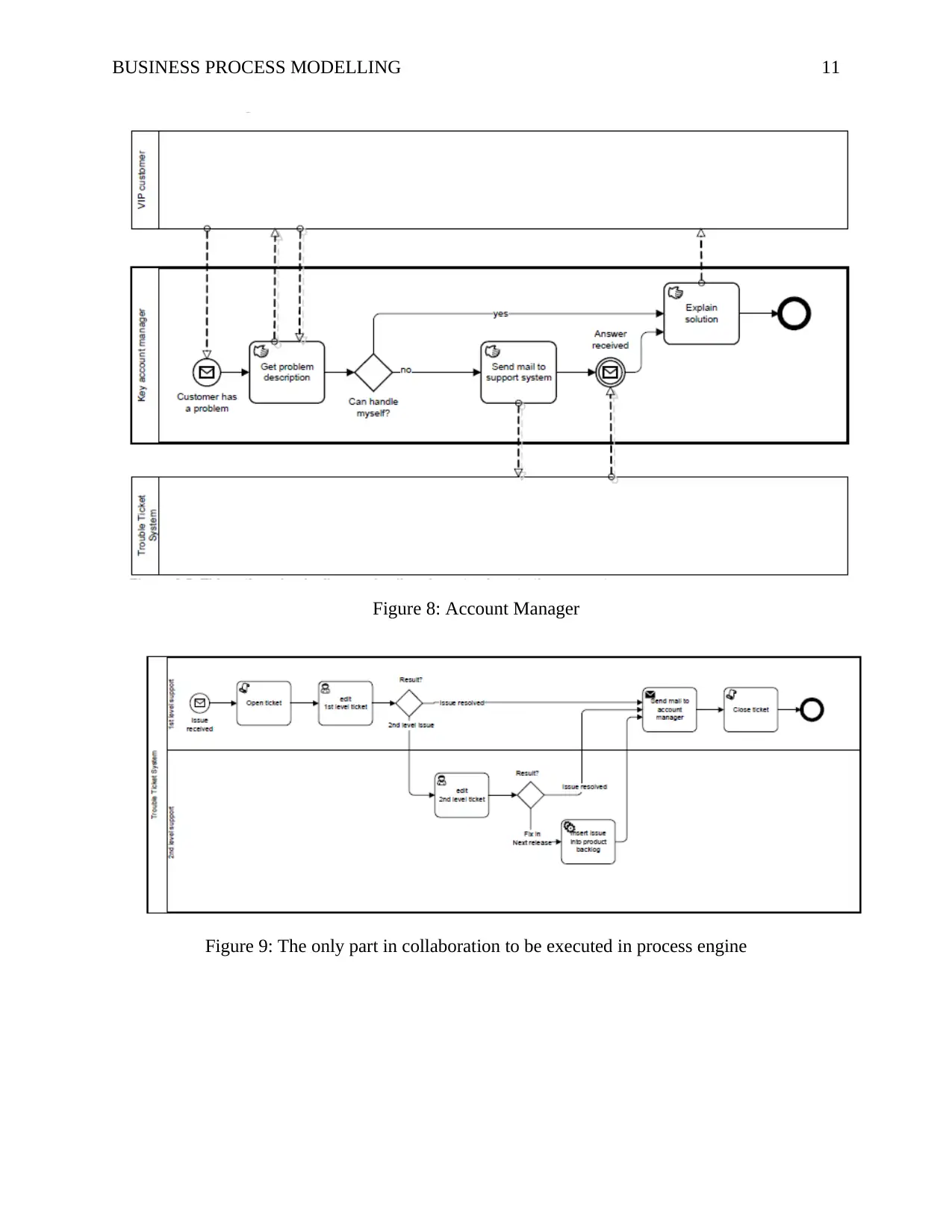
BUSINESS PROCESS MODELLING 11
Figure 8: Account Manager
Figure 9: The only part in collaboration to be executed in process engine
Figure 8: Account Manager
Figure 9: The only part in collaboration to be executed in process engine
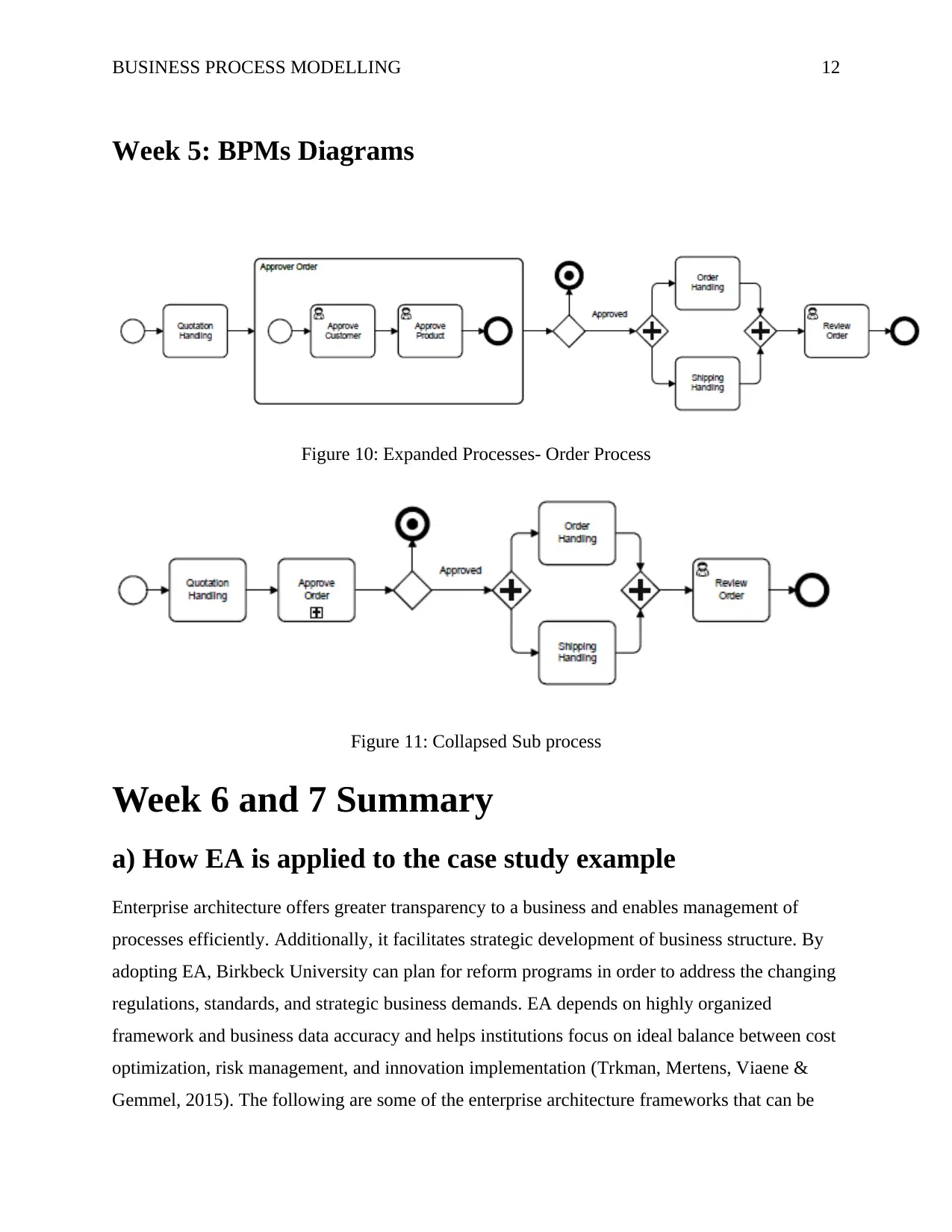
BUSINESS PROCESS MODELLING 12
Week 5: BPMs Diagrams
Figure 10: Expanded Processes- Order Process
Figure 11: Collapsed Sub process
Week 6 and 7 Summary
a) How EA is applied to the case study example
Enterprise architecture offers greater transparency to a business and enables management of
processes efficiently. Additionally, it facilitates strategic development of business structure. By
adopting EA, Birkbeck University can plan for reform programs in order to address the changing
regulations, standards, and strategic business demands. EA depends on highly organized
framework and business data accuracy and helps institutions focus on ideal balance between cost
optimization, risk management, and innovation implementation (Trkman, Mertens, Viaene &
Gemmel, 2015). The following are some of the enterprise architecture frameworks that can be
Week 5: BPMs Diagrams
Figure 10: Expanded Processes- Order Process
Figure 11: Collapsed Sub process
Week 6 and 7 Summary
a) How EA is applied to the case study example
Enterprise architecture offers greater transparency to a business and enables management of
processes efficiently. Additionally, it facilitates strategic development of business structure. By
adopting EA, Birkbeck University can plan for reform programs in order to address the changing
regulations, standards, and strategic business demands. EA depends on highly organized
framework and business data accuracy and helps institutions focus on ideal balance between cost
optimization, risk management, and innovation implementation (Trkman, Mertens, Viaene &
Gemmel, 2015). The following are some of the enterprise architecture frameworks that can be
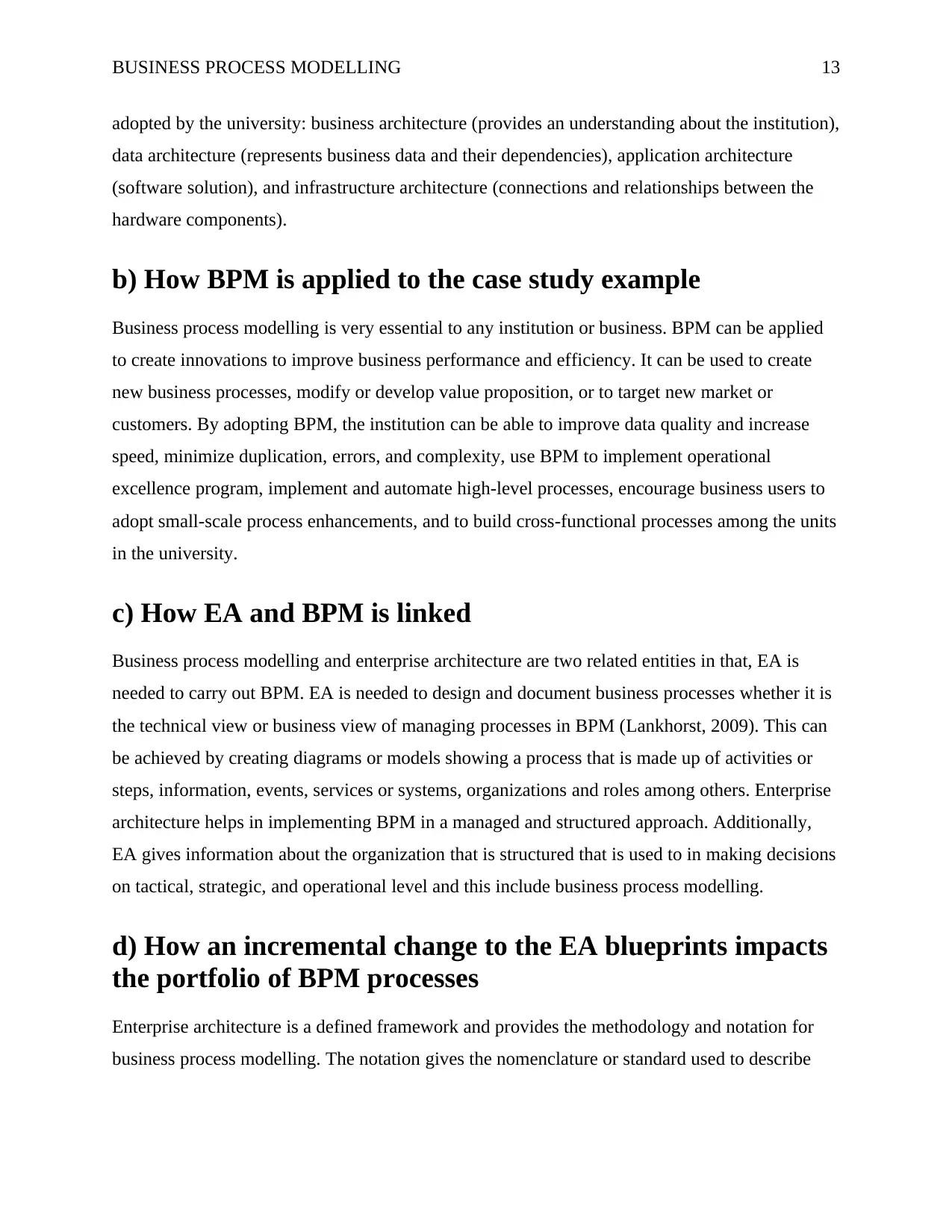
BUSINESS PROCESS MODELLING 13
adopted by the university: business architecture (provides an understanding about the institution),
data architecture (represents business data and their dependencies), application architecture
(software solution), and infrastructure architecture (connections and relationships between the
hardware components).
b) How BPM is applied to the case study example
Business process modelling is very essential to any institution or business. BPM can be applied
to create innovations to improve business performance and efficiency. It can be used to create
new business processes, modify or develop value proposition, or to target new market or
customers. By adopting BPM, the institution can be able to improve data quality and increase
speed, minimize duplication, errors, and complexity, use BPM to implement operational
excellence program, implement and automate high-level processes, encourage business users to
adopt small-scale process enhancements, and to build cross-functional processes among the units
in the university.
c) How EA and BPM is linked
Business process modelling and enterprise architecture are two related entities in that, EA is
needed to carry out BPM. EA is needed to design and document business processes whether it is
the technical view or business view of managing processes in BPM (Lankhorst, 2009). This can
be achieved by creating diagrams or models showing a process that is made up of activities or
steps, information, events, services or systems, organizations and roles among others. Enterprise
architecture helps in implementing BPM in a managed and structured approach. Additionally,
EA gives information about the organization that is structured that is used to in making decisions
on tactical, strategic, and operational level and this include business process modelling.
d) How an incremental change to the EA blueprints impacts
the portfolio of BPM processes
Enterprise architecture is a defined framework and provides the methodology and notation for
business process modelling. The notation gives the nomenclature or standard used to describe
adopted by the university: business architecture (provides an understanding about the institution),
data architecture (represents business data and their dependencies), application architecture
(software solution), and infrastructure architecture (connections and relationships between the
hardware components).
b) How BPM is applied to the case study example
Business process modelling is very essential to any institution or business. BPM can be applied
to create innovations to improve business performance and efficiency. It can be used to create
new business processes, modify or develop value proposition, or to target new market or
customers. By adopting BPM, the institution can be able to improve data quality and increase
speed, minimize duplication, errors, and complexity, use BPM to implement operational
excellence program, implement and automate high-level processes, encourage business users to
adopt small-scale process enhancements, and to build cross-functional processes among the units
in the university.
c) How EA and BPM is linked
Business process modelling and enterprise architecture are two related entities in that, EA is
needed to carry out BPM. EA is needed to design and document business processes whether it is
the technical view or business view of managing processes in BPM (Lankhorst, 2009). This can
be achieved by creating diagrams or models showing a process that is made up of activities or
steps, information, events, services or systems, organizations and roles among others. Enterprise
architecture helps in implementing BPM in a managed and structured approach. Additionally,
EA gives information about the organization that is structured that is used to in making decisions
on tactical, strategic, and operational level and this include business process modelling.
d) How an incremental change to the EA blueprints impacts
the portfolio of BPM processes
Enterprise architecture is a defined framework and provides the methodology and notation for
business process modelling. The notation gives the nomenclature or standard used to describe
Paraphrase This Document
Need a fresh take? Get an instant paraphrase of this document with our AI Paraphraser
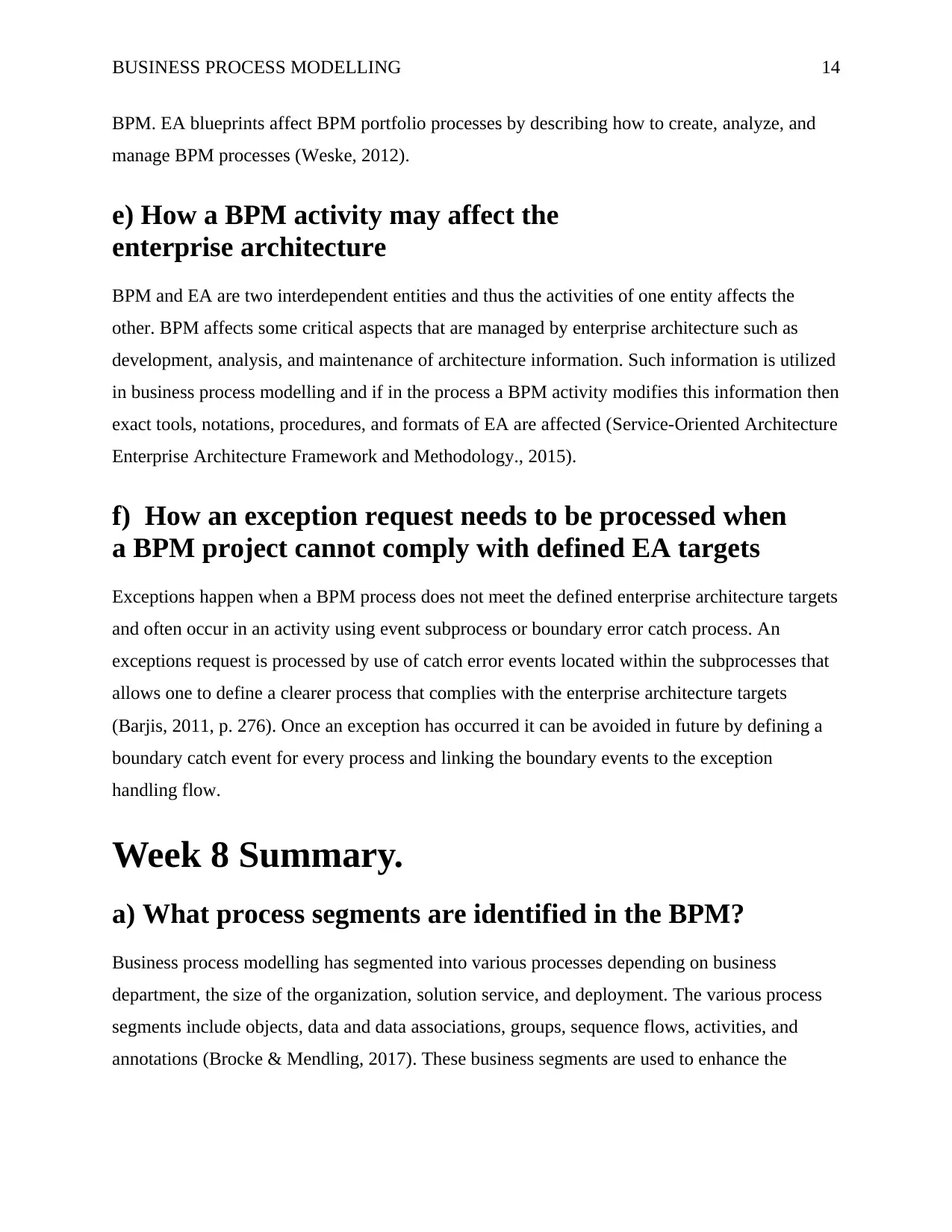
BUSINESS PROCESS MODELLING 14
BPM. EA blueprints affect BPM portfolio processes by describing how to create, analyze, and
manage BPM processes (Weske, 2012).
e) How a BPM activity may affect the
enterprise architecture
BPM and EA are two interdependent entities and thus the activities of one entity affects the
other. BPM affects some critical aspects that are managed by enterprise architecture such as
development, analysis, and maintenance of architecture information. Such information is utilized
in business process modelling and if in the process a BPM activity modifies this information then
exact tools, notations, procedures, and formats of EA are affected (Service-Oriented Architecture
Enterprise Architecture Framework and Methodology., 2015).
f) How an exception request needs to be processed when
a BPM project cannot comply with defined EA targets
Exceptions happen when a BPM process does not meet the defined enterprise architecture targets
and often occur in an activity using event subprocess or boundary error catch process. An
exceptions request is processed by use of catch error events located within the subprocesses that
allows one to define a clearer process that complies with the enterprise architecture targets
(Barjis, 2011, p. 276). Once an exception has occurred it can be avoided in future by defining a
boundary catch event for every process and linking the boundary events to the exception
handling flow.
Week 8 Summary.
a) What process segments are identified in the BPM?
Business process modelling has segmented into various processes depending on business
department, the size of the organization, solution service, and deployment. The various process
segments include objects, data and data associations, groups, sequence flows, activities, and
annotations (Brocke & Mendling, 2017). These business segments are used to enhance the
BPM. EA blueprints affect BPM portfolio processes by describing how to create, analyze, and
manage BPM processes (Weske, 2012).
e) How a BPM activity may affect the
enterprise architecture
BPM and EA are two interdependent entities and thus the activities of one entity affects the
other. BPM affects some critical aspects that are managed by enterprise architecture such as
development, analysis, and maintenance of architecture information. Such information is utilized
in business process modelling and if in the process a BPM activity modifies this information then
exact tools, notations, procedures, and formats of EA are affected (Service-Oriented Architecture
Enterprise Architecture Framework and Methodology., 2015).
f) How an exception request needs to be processed when
a BPM project cannot comply with defined EA targets
Exceptions happen when a BPM process does not meet the defined enterprise architecture targets
and often occur in an activity using event subprocess or boundary error catch process. An
exceptions request is processed by use of catch error events located within the subprocesses that
allows one to define a clearer process that complies with the enterprise architecture targets
(Barjis, 2011, p. 276). Once an exception has occurred it can be avoided in future by defining a
boundary catch event for every process and linking the boundary events to the exception
handling flow.
Week 8 Summary.
a) What process segments are identified in the BPM?
Business process modelling has segmented into various processes depending on business
department, the size of the organization, solution service, and deployment. The various process
segments include objects, data and data associations, groups, sequence flows, activities, and
annotations (Brocke & Mendling, 2017). These business segments are used to enhance the
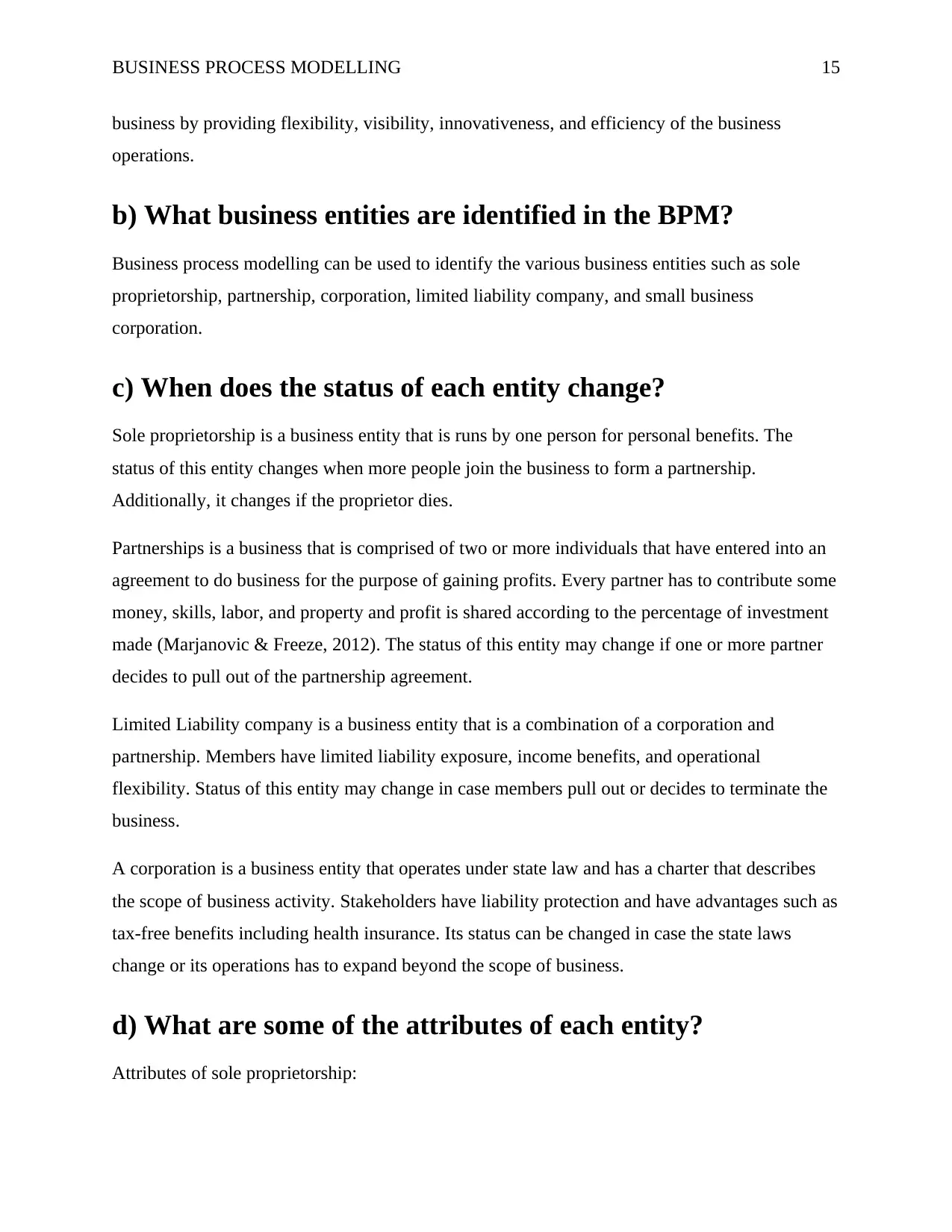
BUSINESS PROCESS MODELLING 15
business by providing flexibility, visibility, innovativeness, and efficiency of the business
operations.
b) What business entities are identified in the BPM?
Business process modelling can be used to identify the various business entities such as sole
proprietorship, partnership, corporation, limited liability company, and small business
corporation.
c) When does the status of each entity change?
Sole proprietorship is a business entity that is runs by one person for personal benefits. The
status of this entity changes when more people join the business to form a partnership.
Additionally, it changes if the proprietor dies.
Partnerships is a business that is comprised of two or more individuals that have entered into an
agreement to do business for the purpose of gaining profits. Every partner has to contribute some
money, skills, labor, and property and profit is shared according to the percentage of investment
made (Marjanovic & Freeze, 2012). The status of this entity may change if one or more partner
decides to pull out of the partnership agreement.
Limited Liability company is a business entity that is a combination of a corporation and
partnership. Members have limited liability exposure, income benefits, and operational
flexibility. Status of this entity may change in case members pull out or decides to terminate the
business.
A corporation is a business entity that operates under state law and has a charter that describes
the scope of business activity. Stakeholders have liability protection and have advantages such as
tax-free benefits including health insurance. Its status can be changed in case the state laws
change or its operations has to expand beyond the scope of business.
d) What are some of the attributes of each entity?
Attributes of sole proprietorship:
business by providing flexibility, visibility, innovativeness, and efficiency of the business
operations.
b) What business entities are identified in the BPM?
Business process modelling can be used to identify the various business entities such as sole
proprietorship, partnership, corporation, limited liability company, and small business
corporation.
c) When does the status of each entity change?
Sole proprietorship is a business entity that is runs by one person for personal benefits. The
status of this entity changes when more people join the business to form a partnership.
Additionally, it changes if the proprietor dies.
Partnerships is a business that is comprised of two or more individuals that have entered into an
agreement to do business for the purpose of gaining profits. Every partner has to contribute some
money, skills, labor, and property and profit is shared according to the percentage of investment
made (Marjanovic & Freeze, 2012). The status of this entity may change if one or more partner
decides to pull out of the partnership agreement.
Limited Liability company is a business entity that is a combination of a corporation and
partnership. Members have limited liability exposure, income benefits, and operational
flexibility. Status of this entity may change in case members pull out or decides to terminate the
business.
A corporation is a business entity that operates under state law and has a charter that describes
the scope of business activity. Stakeholders have liability protection and have advantages such as
tax-free benefits including health insurance. Its status can be changed in case the state laws
change or its operations has to expand beyond the scope of business.
d) What are some of the attributes of each entity?
Attributes of sole proprietorship:
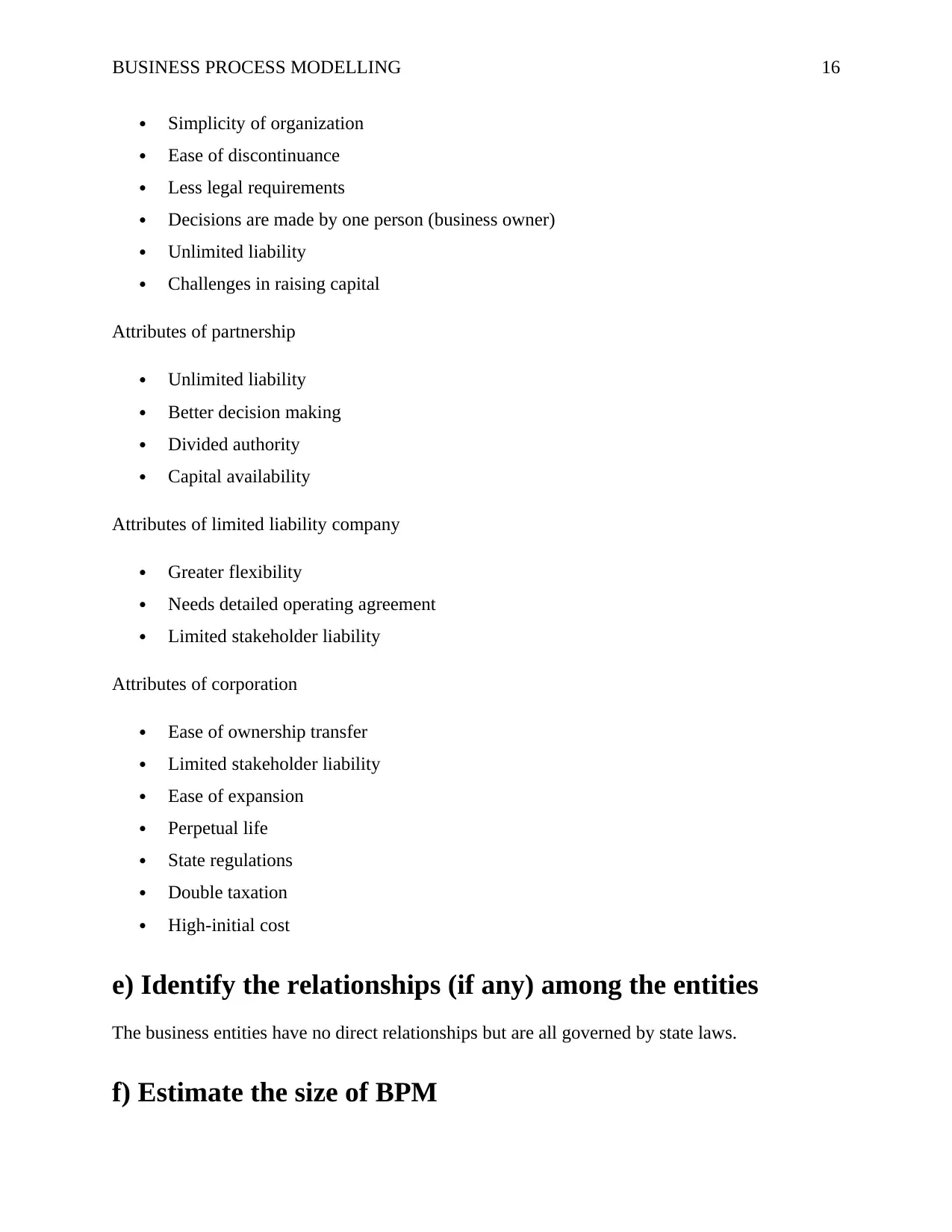
BUSINESS PROCESS MODELLING 16
Simplicity of organization
Ease of discontinuance
Less legal requirements
Decisions are made by one person (business owner)
Unlimited liability
Challenges in raising capital
Attributes of partnership
Unlimited liability
Better decision making
Divided authority
Capital availability
Attributes of limited liability company
Greater flexibility
Needs detailed operating agreement
Limited stakeholder liability
Attributes of corporation
Ease of ownership transfer
Limited stakeholder liability
Ease of expansion
Perpetual life
State regulations
Double taxation
High-initial cost
e) Identify the relationships (if any) among the entities
The business entities have no direct relationships but are all governed by state laws.
f) Estimate the size of BPM
Simplicity of organization
Ease of discontinuance
Less legal requirements
Decisions are made by one person (business owner)
Unlimited liability
Challenges in raising capital
Attributes of partnership
Unlimited liability
Better decision making
Divided authority
Capital availability
Attributes of limited liability company
Greater flexibility
Needs detailed operating agreement
Limited stakeholder liability
Attributes of corporation
Ease of ownership transfer
Limited stakeholder liability
Ease of expansion
Perpetual life
State regulations
Double taxation
High-initial cost
e) Identify the relationships (if any) among the entities
The business entities have no direct relationships but are all governed by state laws.
f) Estimate the size of BPM
Secure Best Marks with AI Grader
Need help grading? Try our AI Grader for instant feedback on your assignments.
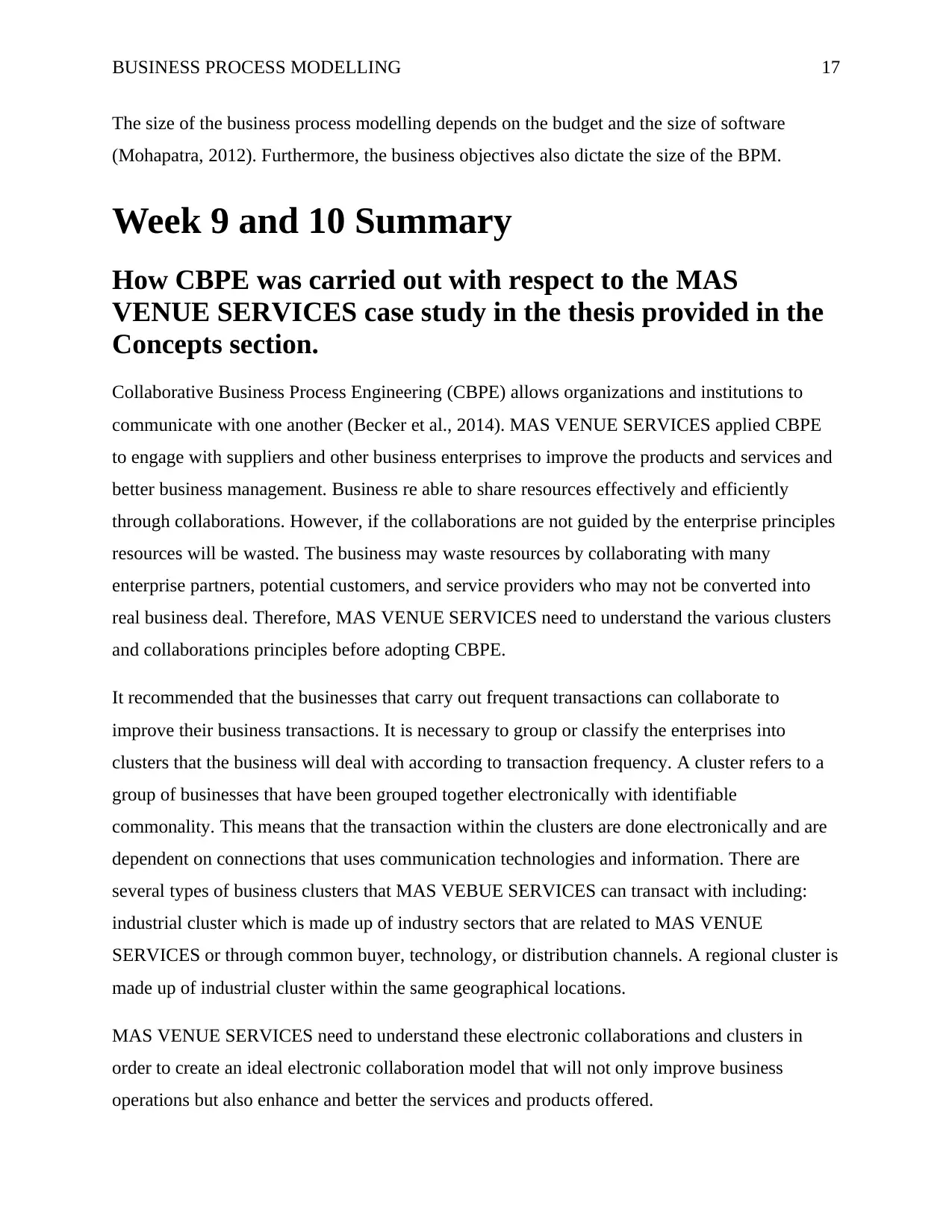
BUSINESS PROCESS MODELLING 17
The size of the business process modelling depends on the budget and the size of software
(Mohapatra, 2012). Furthermore, the business objectives also dictate the size of the BPM.
Week 9 and 10 Summary
How CBPE was carried out with respect to the MAS
VENUE SERVICES case study in the thesis provided in the
Concepts section.
Collaborative Business Process Engineering (CBPE) allows organizations and institutions to
communicate with one another (Becker et al., 2014). MAS VENUE SERVICES applied CBPE
to engage with suppliers and other business enterprises to improve the products and services and
better business management. Business re able to share resources effectively and efficiently
through collaborations. However, if the collaborations are not guided by the enterprise principles
resources will be wasted. The business may waste resources by collaborating with many
enterprise partners, potential customers, and service providers who may not be converted into
real business deal. Therefore, MAS VENUE SERVICES need to understand the various clusters
and collaborations principles before adopting CBPE.
It recommended that the businesses that carry out frequent transactions can collaborate to
improve their business transactions. It is necessary to group or classify the enterprises into
clusters that the business will deal with according to transaction frequency. A cluster refers to a
group of businesses that have been grouped together electronically with identifiable
commonality. This means that the transaction within the clusters are done electronically and are
dependent on connections that uses communication technologies and information. There are
several types of business clusters that MAS VEBUE SERVICES can transact with including:
industrial cluster which is made up of industry sectors that are related to MAS VENUE
SERVICES or through common buyer, technology, or distribution channels. A regional cluster is
made up of industrial cluster within the same geographical locations.
MAS VENUE SERVICES need to understand these electronic collaborations and clusters in
order to create an ideal electronic collaboration model that will not only improve business
operations but also enhance and better the services and products offered.
The size of the business process modelling depends on the budget and the size of software
(Mohapatra, 2012). Furthermore, the business objectives also dictate the size of the BPM.
Week 9 and 10 Summary
How CBPE was carried out with respect to the MAS
VENUE SERVICES case study in the thesis provided in the
Concepts section.
Collaborative Business Process Engineering (CBPE) allows organizations and institutions to
communicate with one another (Becker et al., 2014). MAS VENUE SERVICES applied CBPE
to engage with suppliers and other business enterprises to improve the products and services and
better business management. Business re able to share resources effectively and efficiently
through collaborations. However, if the collaborations are not guided by the enterprise principles
resources will be wasted. The business may waste resources by collaborating with many
enterprise partners, potential customers, and service providers who may not be converted into
real business deal. Therefore, MAS VENUE SERVICES need to understand the various clusters
and collaborations principles before adopting CBPE.
It recommended that the businesses that carry out frequent transactions can collaborate to
improve their business transactions. It is necessary to group or classify the enterprises into
clusters that the business will deal with according to transaction frequency. A cluster refers to a
group of businesses that have been grouped together electronically with identifiable
commonality. This means that the transaction within the clusters are done electronically and are
dependent on connections that uses communication technologies and information. There are
several types of business clusters that MAS VEBUE SERVICES can transact with including:
industrial cluster which is made up of industry sectors that are related to MAS VENUE
SERVICES or through common buyer, technology, or distribution channels. A regional cluster is
made up of industrial cluster within the same geographical locations.
MAS VENUE SERVICES need to understand these electronic collaborations and clusters in
order to create an ideal electronic collaboration model that will not only improve business
operations but also enhance and better the services and products offered.
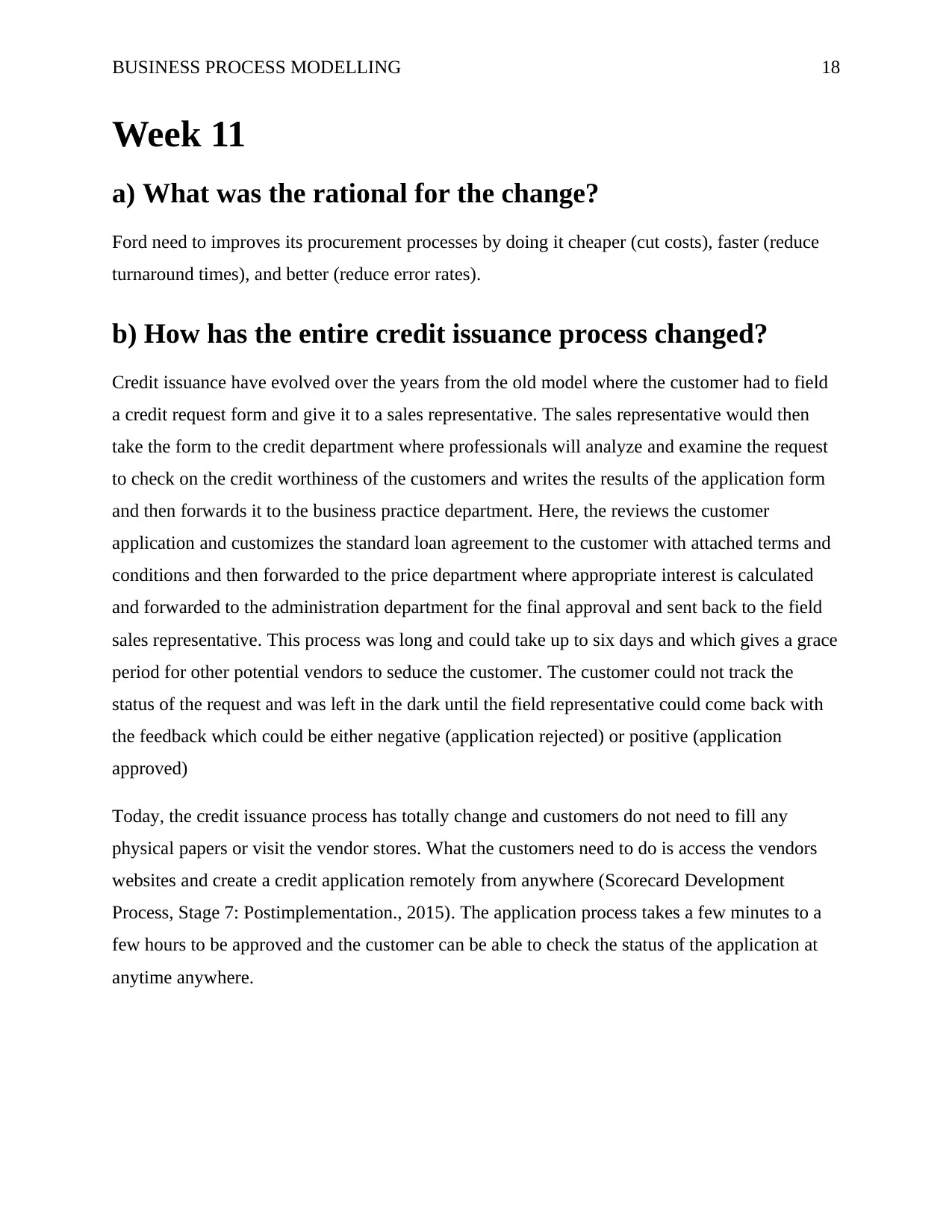
BUSINESS PROCESS MODELLING 18
Week 11
a) What was the rational for the change?
Ford need to improves its procurement processes by doing it cheaper (cut costs), faster (reduce
turnaround times), and better (reduce error rates).
b) How has the entire credit issuance process changed?
Credit issuance have evolved over the years from the old model where the customer had to field
a credit request form and give it to a sales representative. The sales representative would then
take the form to the credit department where professionals will analyze and examine the request
to check on the credit worthiness of the customers and writes the results of the application form
and then forwards it to the business practice department. Here, the reviews the customer
application and customizes the standard loan agreement to the customer with attached terms and
conditions and then forwarded to the price department where appropriate interest is calculated
and forwarded to the administration department for the final approval and sent back to the field
sales representative. This process was long and could take up to six days and which gives a grace
period for other potential vendors to seduce the customer. The customer could not track the
status of the request and was left in the dark until the field representative could come back with
the feedback which could be either negative (application rejected) or positive (application
approved)
Today, the credit issuance process has totally change and customers do not need to fill any
physical papers or visit the vendor stores. What the customers need to do is access the vendors
websites and create a credit application remotely from anywhere (Scorecard Development
Process, Stage 7: Postimplementation., 2015). The application process takes a few minutes to a
few hours to be approved and the customer can be able to check the status of the application at
anytime anywhere.
Week 11
a) What was the rational for the change?
Ford need to improves its procurement processes by doing it cheaper (cut costs), faster (reduce
turnaround times), and better (reduce error rates).
b) How has the entire credit issuance process changed?
Credit issuance have evolved over the years from the old model where the customer had to field
a credit request form and give it to a sales representative. The sales representative would then
take the form to the credit department where professionals will analyze and examine the request
to check on the credit worthiness of the customers and writes the results of the application form
and then forwards it to the business practice department. Here, the reviews the customer
application and customizes the standard loan agreement to the customer with attached terms and
conditions and then forwarded to the price department where appropriate interest is calculated
and forwarded to the administration department for the final approval and sent back to the field
sales representative. This process was long and could take up to six days and which gives a grace
period for other potential vendors to seduce the customer. The customer could not track the
status of the request and was left in the dark until the field representative could come back with
the feedback which could be either negative (application rejected) or positive (application
approved)
Today, the credit issuance process has totally change and customers do not need to fill any
physical papers or visit the vendor stores. What the customers need to do is access the vendors
websites and create a credit application remotely from anywhere (Scorecard Development
Process, Stage 7: Postimplementation., 2015). The application process takes a few minutes to a
few hours to be approved and the customer can be able to check the status of the application at
anytime anywhere.
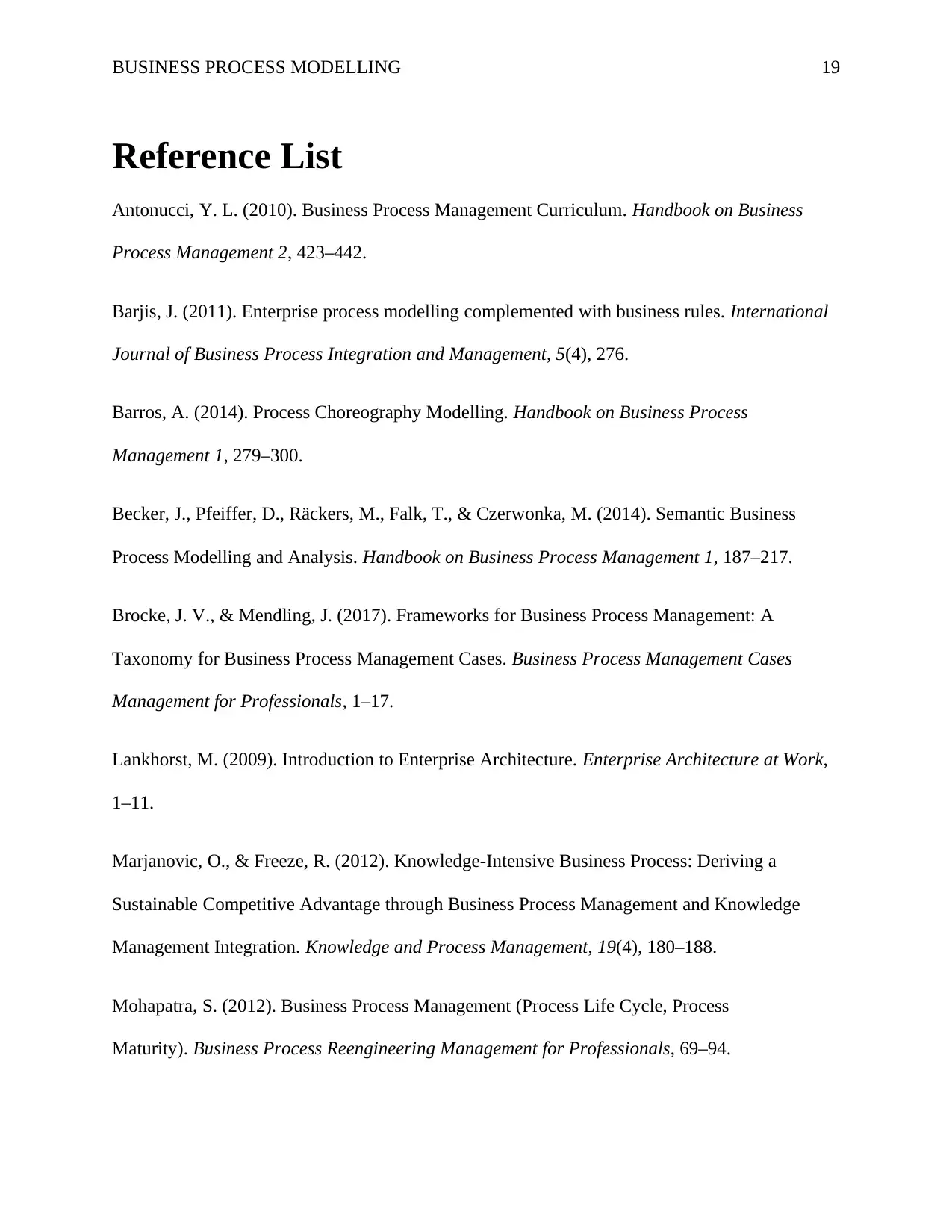
BUSINESS PROCESS MODELLING 19
Reference List
Antonucci, Y. L. (2010). Business Process Management Curriculum. Handbook on Business
Process Management 2, 423–442.
Barjis, J. (2011). Enterprise process modelling complemented with business rules. International
Journal of Business Process Integration and Management, 5(4), 276.
Barros, A. (2014). Process Choreography Modelling. Handbook on Business Process
Management 1, 279–300.
Becker, J., Pfeiffer, D., Räckers, M., Falk, T., & Czerwonka, M. (2014). Semantic Business
Process Modelling and Analysis. Handbook on Business Process Management 1, 187–217.
Brocke, J. V., & Mendling, J. (2017). Frameworks for Business Process Management: A
Taxonomy for Business Process Management Cases. Business Process Management Cases
Management for Professionals, 1–17.
Lankhorst, M. (2009). Introduction to Enterprise Architecture. Enterprise Architecture at Work,
1–11.
Marjanovic, O., & Freeze, R. (2012). Knowledge-Intensive Business Process: Deriving a
Sustainable Competitive Advantage through Business Process Management and Knowledge
Management Integration. Knowledge and Process Management, 19(4), 180–188.
Mohapatra, S. (2012). Business Process Management (Process Life Cycle, Process
Maturity). Business Process Reengineering Management for Professionals, 69–94.
Reference List
Antonucci, Y. L. (2010). Business Process Management Curriculum. Handbook on Business
Process Management 2, 423–442.
Barjis, J. (2011). Enterprise process modelling complemented with business rules. International
Journal of Business Process Integration and Management, 5(4), 276.
Barros, A. (2014). Process Choreography Modelling. Handbook on Business Process
Management 1, 279–300.
Becker, J., Pfeiffer, D., Räckers, M., Falk, T., & Czerwonka, M. (2014). Semantic Business
Process Modelling and Analysis. Handbook on Business Process Management 1, 187–217.
Brocke, J. V., & Mendling, J. (2017). Frameworks for Business Process Management: A
Taxonomy for Business Process Management Cases. Business Process Management Cases
Management for Professionals, 1–17.
Lankhorst, M. (2009). Introduction to Enterprise Architecture. Enterprise Architecture at Work,
1–11.
Marjanovic, O., & Freeze, R. (2012). Knowledge-Intensive Business Process: Deriving a
Sustainable Competitive Advantage through Business Process Management and Knowledge
Management Integration. Knowledge and Process Management, 19(4), 180–188.
Mohapatra, S. (2012). Business Process Management (Process Life Cycle, Process
Maturity). Business Process Reengineering Management for Professionals, 69–94.
Paraphrase This Document
Need a fresh take? Get an instant paraphrase of this document with our AI Paraphraser
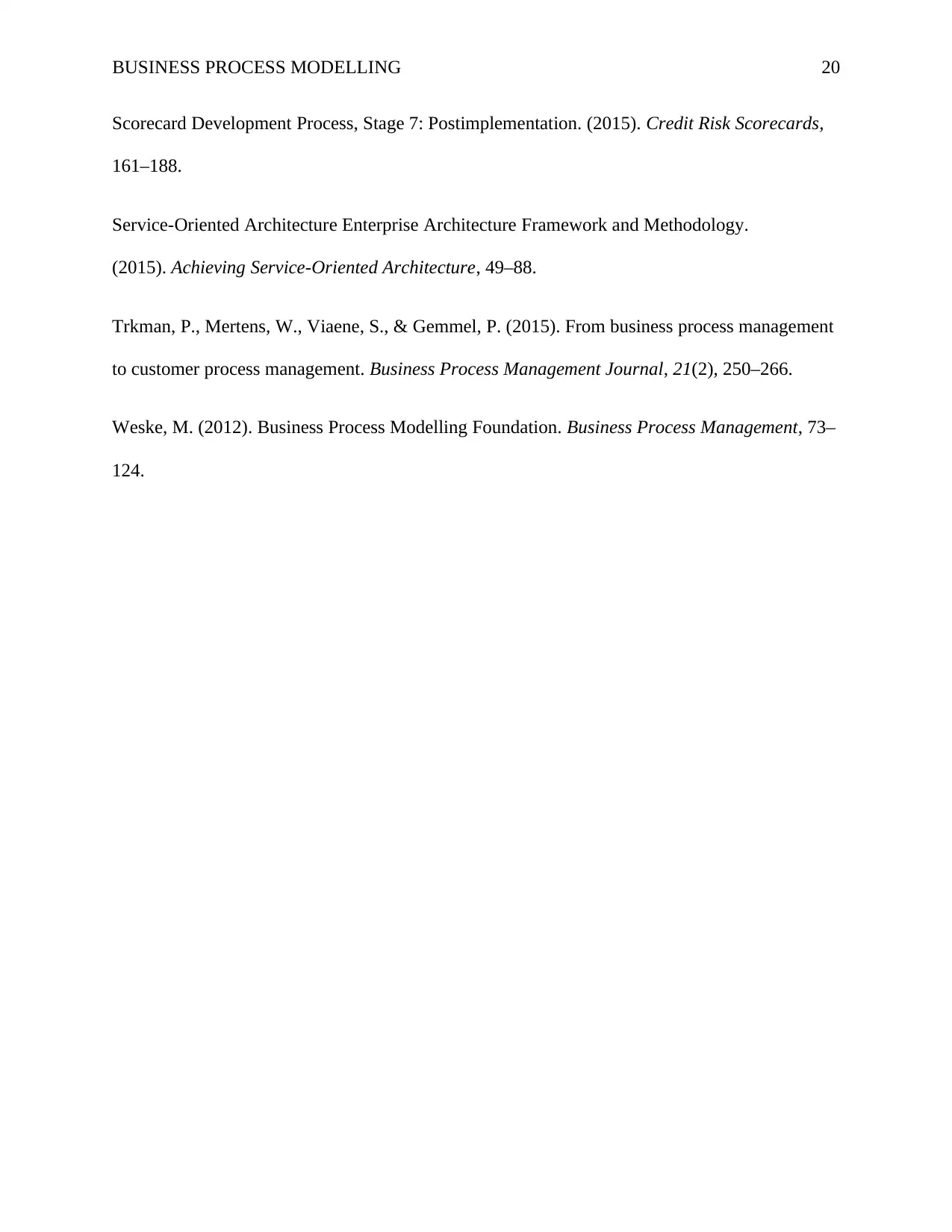
BUSINESS PROCESS MODELLING 20
Scorecard Development Process, Stage 7: Postimplementation. (2015). Credit Risk Scorecards,
161–188.
Service-Oriented Architecture Enterprise Architecture Framework and Methodology.
(2015). Achieving Service-Oriented Architecture, 49–88.
Trkman, P., Mertens, W., Viaene, S., & Gemmel, P. (2015). From business process management
to customer process management. Business Process Management Journal, 21(2), 250–266.
Weske, M. (2012). Business Process Modelling Foundation. Business Process Management, 73–
124.
Scorecard Development Process, Stage 7: Postimplementation. (2015). Credit Risk Scorecards,
161–188.
Service-Oriented Architecture Enterprise Architecture Framework and Methodology.
(2015). Achieving Service-Oriented Architecture, 49–88.
Trkman, P., Mertens, W., Viaene, S., & Gemmel, P. (2015). From business process management
to customer process management. Business Process Management Journal, 21(2), 250–266.
Weske, M. (2012). Business Process Modelling Foundation. Business Process Management, 73–
124.
1 out of 20
Related Documents
Your All-in-One AI-Powered Toolkit for Academic Success.
+13062052269
info@desklib.com
Available 24*7 on WhatsApp / Email
![[object Object]](/_next/static/media/star-bottom.7253800d.svg)
Unlock your academic potential
© 2024 | Zucol Services PVT LTD | All rights reserved.




